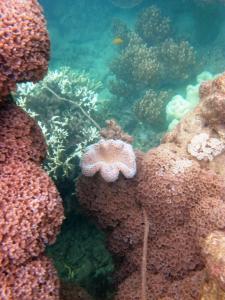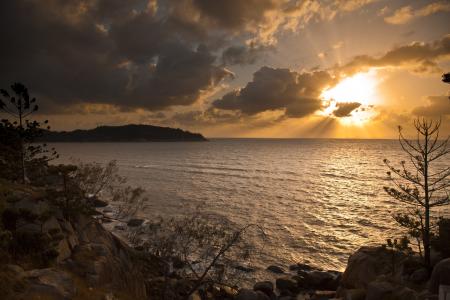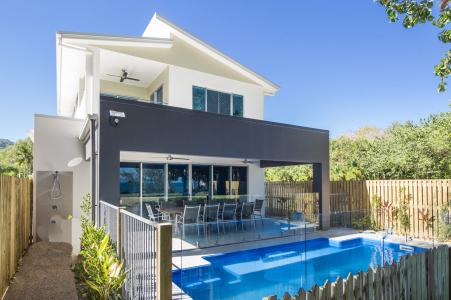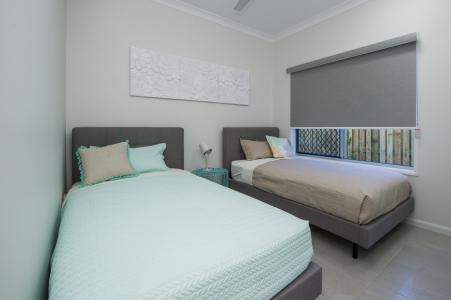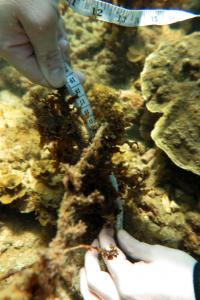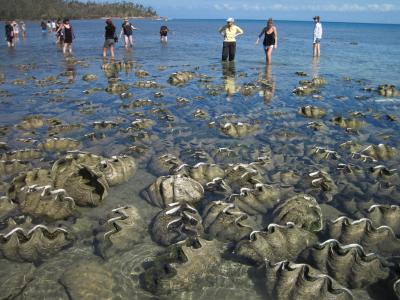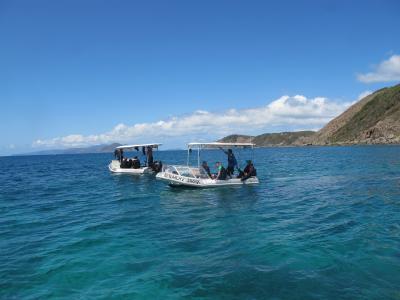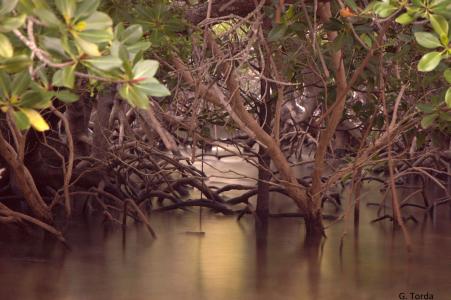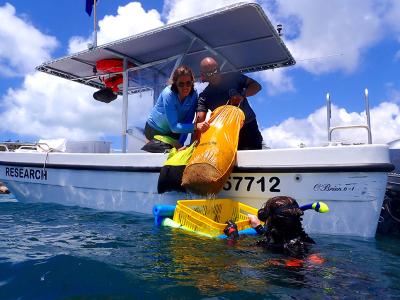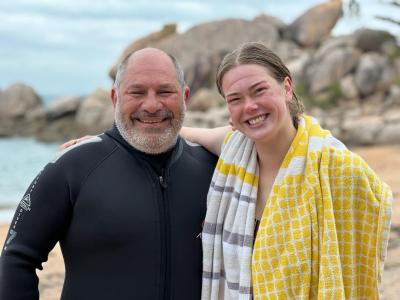.
The Research
The Great Barrier Reef (GBR) supports one of the most diverse marine ecosystems on the planet and provides large economic benefits through fisheries, tourism and other marine related industries. However, a long-term reef-monitoring program has shown that coral cover on the GBR has halved in the last three decades. Some of the largest identified contributors to the decline of GBR corals are storm-derived physical damage, bleaching and disease. Whether coral reefs damaged by severe disturbance events undergo coral recovery (i.e., the restoration of abundance and composition of coral communities) or a phase shift to ecosystems dominated by non-coral organisms (e.g., macroalgae) defines the resilience of coral reefs, and is often influenced by ecological conditions.
In addition to researching coral disease, previous Recovery of the Great Barrier Reef expeditions on Orpheus Island has helped to understand the recovery of coral communities after severe disturbance and the underlying mechanism of coral recovery. For example, it has been shown that branching corals are quick to recolonize areas, and that areas of high wave exposure have higher density of new coral colonies following disturbances. These studies have provided invaluable information on the fine-scale processes involved in the recovery of coral reefs, specifically around the dynamics of coral populations that are essential for determining reef resilience following major disturbance.
However, we have moved into an era when repeated disturbance impacts (storms, bleaching, disease outbreaks) have resulted in concerning ongoing declines of reef health globally. Active management intervention has now become a priority for many reef managers, including the Great Barrier Reef Marine Park Authority (GBRMPA) In July 2018 GBRMPA updated its “Reef 2050” plan the overarching framework for protecting and managing the reef with practical and novel interventions to improve reef health. The baseline information provided by earlier work that established how reefs recover from disturbance can therefore be used to assess the success of any active reef intervention strategy.
Macroalgae flourishes under conditions where terrestrial runoff, increased sedimentation and nutrient loading creates an environment more conducive to macroalgal growth. However, other disturbance events such as storms, mass bleaching, and even reduced herbivory creates space for further opportunistic macroalgae proliferation, thereby additionally reducing the opportunity for coral recovery. These conditions can prompt a shift from a coral to a less desirable macroalgae-dominated regime. Importantly, the return of coral dominance is rare once newly dominant fleshy macroalgae communities have established. While many of the fundamental mechanisms that underpin macroalgae regime shifts have been identified, their persistence and reasoning for why macroalgae regimes are difficult to reverse back to a coral dominated environment are still poorly understood.
The key drivers of coral decline need to be addressed; however active management options offer potential avenues for increasing reef resilience. Macroalgal removal is one such reef recovery method. By increasing space for growth of existing coral colonies and enhancing available space to facilitate coral recruitment, removal of macroalgae has been proposed as one effective local-scale measure to promote reef recovery. Nevertheless, like other active interventions it has been controversial. Advocates of active algal removal argue that the continuing degradation of coral reefs is evidence enough for the failure of current passive management actions. The negative effects of macroalgae on corals have been documented and include shading, physical and chemical recruitment inhibition, and abrasion. The removal of macroalgae has been promoted as reducing these negative impacts on corals. Critics of algal removal argue that intervention can harm reef systems both directly, through physical damage caused by the act of removal, and indirectly, through the potential negative impacts on associated fish and invertebrate species. Indeed, in moderate abundances macroalgae are part of healthy ecosystem function, providing food and shelter for a number of species. This debate highlights that a more comprehensive understanding of the positive and negative effects of macroalgal removal is needed to assess its effectiveness. The impacts of macroalgal removal at Magnetic Island have not been assessed, and this work aims to fill critical knowledge gaps which will further the ability of managers to make decisions regarding these active reef interventions.
Research Aims
This project has three themed objectives:
- To test and develop best practices for macroalgae removal on the Great Barrier Reef;
- To elucidate the effects of macroalgae removal on corals by assessing changes in coral and algal cover, photobiology and coral recruitment success;
- To elucidate the effects of macroalgae removal on the abundance and diversity of other reef organisms (i.e. fish and other reef invertebrates).
Considering the increasing incidence of macroalgae on coral reefs due to anthropogenic factors, management strategies based on outcomes from this study will be applicable to reef management agencies worldwide.
How You Will Help
Participants will assist scientists in a number of activities throughout the project and activities can be conducted on snorkel or scuba (or a mix of both) depending on the tide height and participant skills and scuba certifications.
Planned activities include:
- Establishing replicate quadrats (5X5m) in representative bays around Magnetic Island. This will require fixing star pickets in the hard substrate at sites, marking the sites with underwater buoys and ensuring accurate GPS coordinates and physical maps of the area and plots within the areas.
- Assess the baseline information of abundance of coral, macroalgae, fish and other species within all plots prior to removal of algae.
- Removal of macroalgae from the bottom reef substrate in replicate 5X5m quadrat plots.
- In situ algal height will also be recorded prior to algal removal, and continue in order to evaluate re-growth in treatment plots.
- The whole 5x5m area will be photographed in 1x1m subsections and coral and algal cover will be estimated and monitored for change over the course of the project (for both control and algae removed plots).
- The photobiology of the dominant species of coral colonies will be assessed in each quadrat at each survey time using a diving pulse amplitude fluorometer (PAM).
- Stationary point counts will be conducted to estimate fish diversity and abundance. For each survey the number, species and size of fish observed over 15 minutes will be recorded.
- ‘Cryptic crawls’ will also be conducted in each plot. Swimming close to the bottom in a grid-like pattern the number, species and size of cryptic and nocturnal species will be recorded.
- All underwater photo and video recording of benthic and fish assemblages both pre-and post macroalgae removal are important activities which will require assistance.
Note that activities may need to be adjusted depending on weather conditions. Your understanding and cooperation is appreciated.
A range of environmental data will also be collected. For example, to assess if removing macroalgae changes sedimentation dynamics for benthic organisms at the sites, sediment trays will be fastened to the substrate for the duration of the project. Sediment trays will be placed in the control plots, the treatment plots before removal (as macroalgae removal will likely increase displaced sediments) and the treatment plots after removal. In addition, water quality samples will be taken and data loggers recording temperature, will be deployed and retrieved at periods during the study.
WHY FIELD RESEARCH?
As an Earthwatch participant, you will spend a significant amount of time each day assisting scientists with data collection. Some of this work will be repetitive, but it is fundamental to our scientific understanding of nature. Ecosystems are incredibly complex. The only way to begin to unravel this complexity is by designing good experiments, and carefully collecting as much data as possible. Without the work of thousands of dedicated scientists, we would know little about climate change, the effects of pollution, the thinning of the ozone layer, the extinction of species, or how to find cures for diseases or improve crops. Without science we would be blind to the world. This is your chance to be part of the scientific effort, to find solutions to pressing environmental and cultural problems, and to enjoy the beauty and diversity of nature as you work.
Life in the Field
Training
This expedition is conducted at the picturesque Magnetic Island near Townsville in Queensland, Australia. Magnetic Island is approximately 12 kilometers offshore from the city of Townsville and accessed via a regular passenger and vehicle ferry. The team will stay in Picnic Bay for ease of access to the research sites around the island including Arthur Bay, and Florence Bay. Before the start of each day’s diving activities a toolbox session’ will be undertaken, to fully explain the aims of the snorkeling and diving activities and how the daily tasks will be performed and achieved. This will include assigning snorkel/dive buddies, work tasks both above and below the water and the expected outcomes.
Any potential hazards or dangers will be discussed especially in relation to updated weather conditions. All participants and project staff will wear full wetsuits, dive booties, fins, snorkel and masks. There will be sun exposure risks for all participants whilst in the field, and many visitors underestimate the strength of the Australian sunshine. High factored waterproof sun block should be worn on exposed areas, and hats should be worn while working outside and above water. During each evening a summary of activities from that day will be undertaken and any problems or issues raised and discussed.
On the first day an overview of the project will be given, providing a brief summary of the goals of the project highlighting the benefits this research can bring to the coral ecology field.
Participants do not need any prior training in research methodologies. All methods, tasks and use of equipment will be outlined and demonstrated at the beginning of the project.
TRANSPORT AND DRIVING POLICY
Transport to Magnetic Island will be provided in a small people mover. After the rendezvous in Townsville participants will be taken to the ferry in the project vehicles for transfer to Magnetic Island. The transfer is approximately 40 minutes.
If participants have driven themselves to the project, they may not drive whilst on the project. This includes driving to and from Magnetic Island on the ferry. Participants who ignore this policy and do drive or ride in another participant’s vehicle during the project will be doing so at their own risk and will not be covered under the Earthwatch nor James Cook University insurance policy for the expedition.
SAFETY BRIEFING
Once participants have settled into the accommodation on Magnetic Island, a further project and safety briefing will be conducted in the common room at the accommodation. This briefing will specifically highlight any safety issues on the Island and sort out basic operating procedures including timetables for cooking, cleaning and planned field activities.
GENERAL DIVE PROCEDURES
To help in the training of participants for the fieldwork, a dive and snorkel induction will be carried out in the calm water near the accommodation. This is planned for the first day just after arrival on Magnetic Island. Participants can acclimatize themselves to the diving and snorkeling activities including preparation, communication involved and familiarization with any equipment to be used (e.g. cameras, transect tapes etc.). After the dive, a debrief will occur to highlight any issues or concerns for participants prior to the start of the science based activities.
All participants that meet the minimum health requirements are allowed to participate in the snorkel activities during this project, but ONLY experienced scuba divers (certified Rescue Divers) are allowed to participate in SCUBA activities, since the research team is counting on the proficiency of scuba divers to be responsible for their own safety and aid others in case of an emergency. Scuba divers will need to be added to James Cook University’s diving registry and provide all the documentation required to ensure they meet and understand all safety procedures, environmental rules and regulations, and safe diving limits. James Cook University and the research team leading the field activities have the right to exclude anyone from participating in SCUBA activities if they fail their checkout dive, dive unsafely, or place themselves or others in a situation of undue risk.
For further information on Earthwatch and James Cook University Diving Requirements please contact the Earthwatch Australia office: +61 (0) 3 9016 7590.
ITINERARY AND DAILY SCHEDULE
Weather and research needs can lead to changes in the daily schedule. We appreciate your cooperation and understanding.
Day 1 Arrival/Travel Day
- 11:00 a.m.–3:00 p.m.
- Arrive at Townsville and meet the team.
- Travel to Magnetic Island
- Settle in accommodation
- Safety briefing and orientation
- Afternoon Organization of research equipment and dive/snorkel gear
- Late afternoon Preliminary dive/snorkel to assess ability of all participants—area near the accommodation
- 6:00 p.m.–7:30 p.m. Dinner
Days 2–4 Fieldwork Days
- 7:00 a.m.–8:00 a.m. Breakfast
- 8:00 a.m.–9:00 a.m.
- Morning brief on the day’s activities
- Outline the aims for the field–based activities for that day.
- Prepare all equipment and supplies and load the boats in preparation for leaving.
- 9:00 a.m.–9:30 a.m. Travel to the site for that day.
- 9:30 a.m.– 4:00 p.m.
- Undertake the day’s field activities, which will usually include 2 x 90 minute snorkels/dives with more than 1-hour surface interval.
- Lunch taken between dives.
- 4:00 p.m.–5:00 p.m.
- Return to accommodation
- Wash all gear, clean required equipment and fill scuba tanks for the next day
- 5:00 p.m.–6:00 p.m. Free time for showers, personal activities
- 6:00 p.m.–7:30 p.m. Dinnertime
- 7:30 p.m.–8:30 p.m. Summary of the day’s activities plus a scientific talk on relevant marine topics.
Day 5: Travel Day
- Morning Breakfast, pack and tidy up and depart Magnetic Island and return to Townsville.
Accommodations and Food
The project is delivered on Magnetic Island, and participants will stay at a beachfront holiday home in Magnetic Island.
* Please note that not every expedition has couples’ or single's accommodations available. Please call or email Earthwatch to check for availability prior to reserving your space(s) on the team.
Single gender rooms are assigned with 2 participants per room. Participants will have access to the kitchen and recreational facilities offered there (e.g. swimming pool).
SLEEPING
Rooms are shared; gender segregated. Couple room requests can be accommodated depending on the available space at the holiday home. Each room is equipped with a ceiling fan, air conditioner, and has screened windows. Bed linens (flat and fitted sheet, pillow and pillowcase) are provided. Participants on Team 2 (July) may encounter cooler overnight temperatures, and so a blanket/sleeping bag (appropriate for the temperatures encountered) may be required depending on how cool you feel at night.
* Earthwatch will honor each person’s assertion of gender identity, respectfully and without judgement. For both teen and adult teams, where logistics dictate single-sex accommodations or other facilities, participant placements will be made in accordance with the gender identity the participant specified on their Earthwatch Participant form and/or preferences indicated in discussions with Earthwatch.
BATHROOMS
There are 4 bathrooms throughout the house. These shared facilities offer hot water showers and toilets. Participants may wish to bring a pair of sandals for the shower.
ELECTRICITY
There is 24-hour electricity and all rooms are equipped with working power sockets. Participants are asked to conserve energy wherever possible to help conserve power consumption. Additionally, due to changes in load demand, this may result in low level surges in the power supply. It is recommended that if visitors are using sensitive electronic equipment to bring surge protection boards.
PERSONAL COMMUNICATIONS
There is no Wi-Fi at the accommodation, neither desktop internet nor computers so participants will have to bring their own laptop and Wi-Fi dongles should they wish or need to use the internet during the expedition. Mobile phone reception is widely available on Magnetic Island. Telstra Mobile tends to have the best coverage in Australia. Communication between teams of participants on-site will be via VHF radio.
DISTANCE TO THE FIELD SITE
Participants will be transported to the field locations, and the furthest distance between sites is ~8 km by land. All sites are within the bays of Magnetic Island and so accessible from shore. A boat will provide support for in water activities, though this will depend on what activities are planned for the day/season.
FOOD AND WATER
Earthwatch will provide all food during your stay at the research site.
Participants and staff will be responsible for making their own continental breakfasts in the morning.
Lunch will be had in the field, and participants and project staff will be expected to make their own sandwiches in the morning before departing. Fruit and snack foods (e.g., muesli bars) will be available to pack as well.
Dinner will be a cooked meal and all participants will be expected to participate in the preparation of meals according to a roster. Be prepared to have a little fun with this! The Principal Investigator organizes a friendly “master chef” style competition from the cooking roster, and many participants enjoy this whole- heartedly. Evening meals will be hearty and comprise meats, vegetables, pasta, rice etc. BBQs will be planned but will be dependent on the weather. There will also be one night out at the Arcadia Bay pub for dinner, where meal costs will be covered but any alcoholic beverages will be at participants own cost. This will be to partake in the local tradition of cane toad racing!
Housekeeping will be shared, with small teams assigned to duties each day. Tasks may include washing and drying dishes, sweeping the kitchen floor, wiping benches, cleaning the bathroom, packing away chairs and tables after meals etc. A roster with full tasks will be established on the first day of the project.
Fresh drinking water will always be available at the accommodation quarters. Magnetic Island is supplied with treated potable town water and is suitable for drinking without treatment. Water should not be wasted however as the Island is in the dry tropics.
Tea and coffee will also be readily available at the accommodation.
The following are examples of foods you may find in the field. Variety depends on availability. We appreciate your flexibility.
- Breakfast: Cereal, toast and spreads.
- Lunch: Sandwich meats, spreads and salads, cheese, fresh fruit, muesli bars.
- Dinner: Pasta, curries, stir-fry, BBQ meat and salads, sauces, etc.
- Snacks: Crackers, fruits, sweet biscuits, muesli bars.
- Beverages: Coffee, tea, milk, fruit juices / cordial, water.
SPECIAL DIETARY REQUIREMENTS
Please alert Earthwatch to any special dietary requirements (e.g., diabetes, lactose intolerance, nut or other food allergies, vegetarian or vegan diets) as soon as possible, and note them in the space provided on your participant forms.
Accommodating special diets is not guaranteed and can be very difficult due to availability of food, location of field sites, and other local conditions.
Project Conditions
The following are averages. Please check weather resources for your team dates for more accurate weather predictions. Projects have experienced unseasonable weather at all times of year.
The weather is expected to vary within the limits below.
The climate at Magnetic Island is tropical, with the summer (November to April) hot and humid with temperatures in the high 20sºC (mid 80sºF). The rainy months are from December to March with an average annual rainfall of 1200mm (3.9 ft.).
Summer winds are variable, with extended calm periods. Cyclones developing in the Coral Sea (November to May) may produce strong winds and heavy rains, but rarely threaten the island. Southeast trade winds dominate the cool, sunny, dry season from June to November. During this period daily temperatures may be variable and a range of attire is recommended with overnight temperatures dropping to 20º Celsius.
Water temperatures range from 25 to 27º Celsius (82 to 86º Fahrenheit) in summer and can drop as low as 23º Celsius (75º Fahrenheit) in winter.
GENERAL CONDITIONS
For weather and region-specific information, please visit Wunderground.com and search for your project location.
Essential Eligibility Requirements
PHYSICAL DEMANDS
The project can be very demanding physically, due to strong currents and sea swell. Those who are prone to seasickness should bring preventative treatments with them. If you feel nauseous, it is best to stay in the water rather than get back on board the vessel, as the rocking of the boat is likely to make you feel worse.
EXPECTED DEMANDS OF THE PROJECT
Please keep in mind that conditions may change and the project could potentially be more or less strenuous than these points indicate.
All participants must be able to:
- Follow verbal and/or visual instructions independently or with the assistance of a companion.
- Enjoy being outdoors all day in all types of weather, in the potential presence of wild animals and insects.
- Dive/Swim/Snorkel twice a day for 90 minutes each.
- Sit for 2–3 hours per day (travel via vehicle or boat, evening lectures).
- Walk some distance over rough terrain (up to 1 km) to access research sites (the bays may be away from the roads).
- Carry their dive equipment to and from the boat and/or shore and may help carry research equipment. The distance differs according to the tide level and boat support for the activities, and it may be in shallow water (up to 50 cm).
- Bend up to two hours per day when doing field work and cleaning field gear.
- Work on a boat for 4–6 hours a day. Travel to some research sites may be via boat and take no longer than 30 minutes. One-hour surface time will be spent on the boat or on shore depending on weather conditions.
- Adhere to the briefing guidelines, be aware of their limitations and apply common sense while participating.
- Take an active role in your own safety by recognizing and avoiding hazards if and when they arise (including, but not limited to, those described in Earthwatch materials and safety briefings). Comply with project staff instructions and recommended safety measures at all times.
- Be able to effectively communicate to the staff if you are experiencing distress or need assistance.
- Be comfortable being surrounded by a language and/or culture that is different from your own.
- Be able to get along with a variety of people from different backgrounds and ages, often in close proximity, for the duration of your team.
BOATING REQUIREMENTS
In order to assist on the research boat, you will need to be relatively fit and agile. Although research boats may have a canopy for shading, sun protection is required for the one-hour surface interval and other field activities. Depending on winds, the trip may be bumpy and participants may feel cold on the return trip after being in the water all day. An all-weather proof or windbreaker jacket may be advisable.
DIVING/SNORKELING REQUIREMENTS
Diving/Snorkeling is a physically demanding activity with inherent risks. Safety procedures are established to minimize the risk associated with diving and should be adhered to closely. All participants must be in good physical condition and must have undergone a recent physical examination and provide a doctor’s certificate stating they are fit to conduct the tasks outlined in this briefing (dive or snorkel). Divers must undergo a commercial divers’ health check (AS/NZS 2299 medical, please contact Earthwatch to discuss) provided by a certified SPUMS Dive Examiner.
Snorkelers should have more than 10 hours snorkeling experience in open water and be able to demonstrate basic snorkel skills including correct mask clearing, ear equalization and duck diving. Snorkelers should be comfortable swimming in the open ocean with swells and strong currents, able to swim or tread water for 10 minutes continuously and swim at least 200m (650ft) unaided. Snorkelers must be able to demonstrate full control over their breathing at all times.
To dive on this expedition participants will need to meet the requirements to join the James Cook University Dive Register. At a minimum you will need to hold a Divemaster or Australian Occupational/AQF Rescue Dive Certification as well as other relevant certifications, medical clearance and demonstrable experience).
An individual with heart trouble, a current cold or congestion, ear infection, epilepsy, asthma, a severe medical problem or is under the influence of certain prescription drugs should not dive without a physician’s explicit approval.
Costs may vary between doctors and you may be required to have a chest x-ray as well. You will need to have your x-ray and x-ray report with you for the Occupational/Commercial Dive Medical examination. If you are unable to see a SPUMS registered doctor before your arrival in Australia, you will need to organize an appointment in Australia prior to fielding. It is necessary that you bring your original chest x-ray and doctor’s x-ray report (in English) from your country of residence with you in order for the Occupational/ Commercial Dive Medical to be completed within Australia. You may also be able to have an equivalent medical done in the United States (or elsewhere) through doctors certified by the Undersea and Hyperbaric Medical Society (UHMS) to undertake commercial divers’ exams.
Please note that you will have to arrive at least a day before the project’s commencement if you are seeing a doctor in Australia.
In order to register as a scuba diver on this project, you need to meet the requirements and supply copies of all supporting documentation (see below). In addition, this project in particular requires competent divers. Divers must have experience in low visibility and strong currents. You may be required to present documentation (written log) demonstrating this, therefore the original documents may need to be brought along.
DOCUMENTATION REQUIREMENTS FOR SCUBA DIVERS
- Hold at least an ‘Rescue’ diver certification from a recognized diver training agency
- Copy of last 30 dives from dive log (Please bring full dive log on trip) with evidence that your last dive was within six months of the start date of the project
- Ensure you have logged a minimum of 40 hours of diving (excluding training)
- Have logged at least one dive in the last six months prior to the start date of the project, and in waters similar to those of the planned dive (e.g. temperate)
- If intending to use your own SCUBA diving equipment, it must be serviced within 12 months prior to diving and will be inspected by the Dive Supervisor prior to diving. Evidence to show that the equipment is in current test and/or has been serviced within 12 months prior to diving (i.e. service record from the service shop).
- Hold dive insurance, which provides emergency evacuation service as well as dive accident treatment cover. DAN Dive Insurance or equivalent (stating what type of coverage is provided (e.g. Standard, Preferred or Master). See danasiapacific.org/index.php. *NOTE, holding a DAN membership does not mean that you have a DAN insurance policy, you must have a membership however to purchase insurance
- Hold a First Aid Certificate current within 36 months
- Hold a CPR and O2 provider certificates current within 12 months
- Pass an Occupational/commercial dive medical within 12 months prior to diving by a medical practitioner appropriately trained in underwater medicine and registered with SPUMS*
- Supply a diving medical exam (equivalent to an AS/NZS 2299 standard) from a SPUMS registered doctor dated within 12 months of the start date of the project stating that the diver is fit to dive using compressed air, as well as noting any limitations imposed by the doctor. Please contact the Earthwatch offices by phone or email to ensure that your appointment is for the correct type of medical exam. You can find a doctor nearest to you at the South Pacific Underwater Medicine Society site (SPUMS): spums.org.au/diving-doctors-commercial by clicking the commercial diving doctor list.
- Participants will need to register their qualifications on the James Cook University Boating and Diving office register. Please contact Earthwatch for instructions on how to create an account and upload your certifications.
Health and Safety
EMERGENCIES IN THE FIELD
The nearest medical care and pharmacy is available on Magnetic Island. Participants would be transported by project vehicle to medical assistance, which takes approximately 25 minutes at most. For more serious injuries participants would be transferred directly to the hospital in Townsville. This would take approximately 40 minutes via boat to Townsville then ambulance (if necessary) to the hospital. For life threatening injuries, Royal Flying Doctors will be called and participants would be airlifted from the island directly to Townsville hospital.
Earthwatch has a 24-hour, 7-day-a-week emergency hotline number. Someone is always on call to respond to messages that come into our live answering service.
Physician, Nurse, or EMT on Staff: Project staff are not medical professionals.
Staff Certified in Safety Training: All JCU team members are qualified in CPR and hold a First Aid / oxygen provider certificate. All Earthwatch Team Leaders are qualified in CPR and hold a First Aid certificate.
IMMUNIZATIONS & TRAVEL VACCINATIONS
Please be sure your routine immunizations are up-to-date (for example: diphtheria, pertussis, tetanus, polio, measles, mumps, rubella and varicella) and you have the appropriate vaccinations for your travel destination. Medical decisions are the responsibility of each volunteer and his or her doctor. Visit the Center for Disease Control and Prevention or the World Health Organization for guidance on immunizations.
If traveling from countries or region where yellow fever is endemic, you must have a certificate of vaccination.
MEDICAL CONDITIONS OF SPECIAL CONCERN
Hydrophobia, discomfort in or around boats; uncontrolled inner ear infections, conditions that reduce or limit your ability to equalize pressure in one’s ears; conditions that affect balance, blood clotting issues and/or any condition that interferes with or limits a participants’ swimming or breathing should be considered carefully. If you are pregnant, you should inform your doctor prior to diving. If you suffer from motion or seasickness and intend to treat this with either over-the-counter or prescribed medication, please discuss the use and side effects with your doctor.
CONDITION CONCERNS AND PRECAUTIONS
Medical Complaints: Due to the remoteness of the area and the time it takes to evacuate, those who may require quick access to medical care due to any medical complaints should not take part on this project.
Allergies: Those with known allergies to dust, grasses, mammals, plants or insects (including mosquitoes and sandflies) should bring appropriate medications in order to participate on this project. Those with severe bee sting allergies should bring an Epi-Pen and carry it with them at all times.
Back or neck problems: Those with chronic or constant back or neck pain should be aware that some days may require travelling on the boat in bumpy conditions and should reconsider their ability to participate.
Knee or ankle problems: This project requires bending and lifting as well as participants to walk over uneven and steep terrain.
Physical limitations: Participants with physical limitations should be aware that the work involved generally requires a good level of fitness.
Note: Any prescription medication brought into Australia needs to be accompanied with a letter from your doctor for Customs Inspection purposes.
Project Risks and Precautions
Transportation
Some driving may involve rough roads on 4WD tracks. All vehicles are equipped with airbags, seat belts, spare tires, first aid kit with Emergency Response Plan and mobile phone. Only experienced and suitably qualified project staff will drive vehicles and they will obey all road rules. Passengers and driver will be instructed to wear seat belts at all times whilst the vehicle is in motion. Participants are not allowed to drive (including their own vehicles) while on an Earthwatch team.
Working in boats
Boats are well maintained, and include VHF radio, life preservers, emergency flares, fire extinguisher, and a first aid kit. Life jackets are available for all passengers. All participants and project staff will be wearing wetsuits, which assist with buoyancy. All participants must be able to swim, and must disclose their swimming ability to project staff in advance. The boat is only used in daylight hours and only when sea state is acceptable to the skipper. The skipper is certified and experienced in driving boats in the area. Boat communications include EPIRB, flares, VHF radio and mobile phones. There is a communications plan with the team outlining boat return time, destination and people manifest.
Slips and Trips
Participants may need to board the boat by the boat ramp or by walking out onto the beach to the closest point where the boat can get in due to tides. Participants are instructed to be careful when embarking and disembarking the vessel and should hold onto the handrail or sides of boat. Participants should always wear their booties when walking out on the reef and boarding the boat.
Snorkeling
Snorkeling is a physically demanding activity with inherent risks. Safety procedures are established to minimize the risk associated with snorkeling and outlined during the safety briefing prior to commencing the research activities. Snorkels are to use the appropriate technique to equalize as they duck-dive to avoid eardrum injuries and ensure they know how to use the snorkeling equipment (including how to clear masks and snorkel, appropriate techniques for fin use, and outline some tips on safe breath holding).
Diving
Scuba diving is a physically demanding activity with inherent risks. Safety procedures are established to minimize the risk associated with diving and should be adhered to closely. As with all diving activities there is a risk of decompression illness (DCI). There isn’t a recompression chamber on the island; therefore, there will be strict diving restrictions imposed. Only participants who have passed a dive medical, have appropriate insurance, and have provided evidence of significant dive experience can participate on Earthwatch dive projects. A Dive Supervisor is always present with divers. Oxygen is kept on board the boat. Project staff are first aid qualified. Participants are buddied up based on experience. Participants are guided down and up slowly in order to prevent descending and ascending too quickly. There is a diver response plan in place.
Poisonous and stinging marine animals
There is potential for participants or staff to be stung or bitten by some species of marine life present (for example stonefish, sea snakes, stingrays, and various jellyfish). Participants should wear wetsuits, flippers and mask, which will provide protection from most stinging wildlife. Participants are instructed not to pick anything up or touch any marine creatures. If participants are stung they should alert project staff and apply first aid according to what has caused the sting. Participants should wear booties or some closed footwear when walking in the water and shallow reefs in the bay.
Sharks/Crocodiles
There is low risk of encountering a dangerous shark or a crocodile on the project. If a shark or crocodile is present nearby and advance warning has been given to the team via the local authorities, then research activities will be cancelled in that location. Sharks will most likely demonstrate aggressive behavior before they strike, however, crocodiles are known to be ‘ambush predators’, and so precautions will be taken when near the water (when not on scuba) if a crocodile is known to be present in the area. If a shark is spotted and displaying aggressive behavior, all participants will evacuate the water as quickly as possible.
Heat related illnesses, dehydration
Participants should bring reef-safe waterproof sunscreen. Participants should drink plenty of water throughout the day. If participants start to feel unwell they should notify a project staff member immediately and rest in a shaded area, whilst cooling themselves with water.
Coral rubble and sharp shells
Participants should not go barefoot when walking around the accommodation or when walking out on the reef.
Gas stove
Participants will be cooking on gas stoves and the risk of burns is possible. Participants will be briefed about the cooking facilities and warned to take care when using any gas elements.
Snakes
Venomous snakes are found on the island. If participants come across a snake, they should not try to catch it or kill it. Participants should back away from the snake and let it be. Participants will be briefed on snakes on arrival and advised to wear closed in shoes when walking around the island.
Travel Planning
RENDEZVOUS LOCATION
C Bar, The Strand Townsville, Queensland
* Additional information will be provided by Earthwatch to meet your team. Please do not book travel arrangements such as flights until you have received additional information from Earthwatch.
ABOUT YOUR DESTINATION
Earthwatch strongly recommends that travelers investigate their destination prior to departure. Familiarity with the destination’s entry/exit requirements, visas, local laws, and customs can go a long way to ensuring smooth travel. The U.S. Department of State's Traveler’s Checklist and Destination Guides are helpful resources. For LGBTI travelers, the U.S. Department of State's LGBTI Travelers page contains many useful tips and links.
COUNTRY AND PROJECT ENTRY REQUIREMENTS
Entry visa requirements differ by country of origin, layover, and destination, and do change unexpectedly. For this reason, please confirm your visa requirements at the time of booking and, again, 90 days prior to travel. Please apply early for your visa (we recommend starting 6 months prior to the start of your expedition). Refunds will not be made for volunteers cancelling due to not obtaining their visa in time to meet the team at the rendezvous. You can find up to date visa requirements at the following website: www.travisa.com.
If a visa is required, participants should apply for a TOURIST visa. Please note that obtaining a visa can take weeks or even months. We strongly recommend using a visa agency, which can both expedite and simplify the process.
Generally, passports must be valid for at least six months from the date of entry and a return ticket is required.
Resources
BOOK
- Introduction to Marine Biology. George Karleskint, Richard Turner, James Small. (2006) Brooks/Cole, USA.
ARTICLE
BOOKS
- Coral Reefs in the Microbial Seas (Forest Rohwert)
- Corals of the World (Chalie Veron)
Films
- Coral Reef Adventure (coralfilm.com)
- The Blue Planet (BBC)
- Chasing Coral (NetFlix)
- Saving Atlantis (Oregon University)
PROJECT RELATED LINKS
.
.
.
Recovery of the Great Barrier Reef Gallery
Sign up for the Earthwatch Newsletter
Be the first to know about new expeditions, stories from the field, and exciting Earthwatch news.
.
.
.
